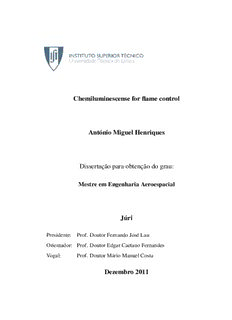
Chemiluminescense for flame control António Miguel Henriques PDF
Preview Chemiluminescense for flame control António Miguel Henriques
Chemiluminescense for flame control António Miguel Henriques Dissertação para obtenção do grau: Mestre em Engenharia Aeroespacial Júri Presidente: Prof. Doutor Fernando José Lau Orientador: Prof. Doutor Edgar Caetano Fernandes Vogal: Prof. Doutor Mário Manuel Costa Dezembro 2011 Resumo Apresentetese aborda o processo de desenho, construção, optimização e teste de um sensor de quimiluminescência, no contexto do desenvolvimento de tecnolo- gias de controlo de combustão. O protótipo desenvolvido neste trabalho adquire a luz emitida pelos radicais excitados OH* e CH*, de forma a explorar a dependência da re- lação OH∗/CH∗ = f(φ) com os sistemas de colecção de luz (na óptica de utilização não intrusiva em motores turbofan) e com a deformação temporal da chama (imposta para simular condições turbulentas). Para os testes utilizou-se uma chama de propano tipo Bunsen,comrazõesdeequivalênciadeφ=[0.861.1],ecomapossibilidadedesedefor- maracusticamenteatravésdeumpulsosinusoidaldeamplitudevariável(∆V =[00.045] V a 50 Hz). Nestas condições, foi possível concluir que OH∗ /CH∗ = f(φ) não é médio médio afectadapeladeformaçãoequeaemissãodequimiluminescêncialocalpoderádepender da deformação da chama. A evolução temporal de OH∗/CH∗ foi usada como entrada nummecanismosimuladodecontrolodecombustão,doqualsemostrouqueosmodelos decontrolobaseadosnaquimiluminescênciamédiapoderãosobrestimarousubestimaro razãodeequivalênciadachamaduranteoseuperíododeactuação. Palavras-chave: Quimiluminescência, combustão pobre, fotomultiplicadores, controlo dechama,turbofan. iii Abstract T heaim of this thesis was to design, construct, optimize and test a chemilumines- cencesensor,inthecontextofleancombustioncontroltechnology. Thedeveloped prototype collects light from OH* and CH* species, in order to evaluate the dependence of the OH∗/CH∗ = f(φ) relation with the optical collecting systems (in the context of non-intrusive measurements in turbofan engines) and with the temporal flame deforma- tion(imposedtosimulateturbulentconditions). ForthetestsapropaneBunsenflamewas used,withequivalenceratiosofφ=[0.861.1]andwiththepossibilitytoacousticallyvary thesuppliedmixturespeed(sinusoidamplitude∆V =[00.045]Vat50Hz)forcontrolled flame deformations. With this setup it was possible to conclude that OH∗ /CH∗ mean mean = f(φ) is not affected by flame deformation and that local chemiluminescence may be dependent on flame deformation. OH∗/CH∗ time evolution was used in a simulated combustion control mechanism, from which it was shown that control models, based in mean chemiluminescence measurements, may overestimate or underestimate real flame equivalenceratio. Keywords: Chemiluminescence, lean combustion, photomultipliers, flame control, tur- bofan. v Acknowledgements I wouldlike to express my utmost gratitude to Professor Edgar Fernandes. If I was going to detail why I should thank him, I would have more pages of gratifications thanpagesofwork. Then, it is important clarify one thing: I could have never walked through this journey without my Friends. I believe that some how, the right friends, in the right place, at the righttime,willtakeyourideastoanywhere. ToFamily,towhomIoweeverythingIam,Idedicatethiswork. "Istovaisersóumacaixaparaapontarparaachama,ejáestá!" vii Contents Resumo iii Abstract v Acknowledgements vii Listoftables xi Listoffigures xvi Listofsymbols xx 1 Introduction 1 1.1 LiteratureReview . . . . . . . . . . . . . . . . . . . . . . . . . . . . . . 9 1.1.1 Chemiluminescenceforcombustioncontrol . . . . . . . . . . . . 9 1.1.2 Chemiluminescenceapplications . . . . . . . . . . . . . . . . . . 16 1.2 ThesisObjective,ContributionandOutline . . . . . . . . . . . . . . . . 20 2 ExperimentalMethods 21 2.1 ChemiluminescenceSensorDesign . . . . . . . . . . . . . . . . . . . . . 23 2.2 DataAcquisition . . . . . . . . . . . . . . . . . . . . . . . . . . . . . . 34 ix 2.3 PrototypeTesting . . . . . . . . . . . . . . . . . . . . . . . . . . . . . . 37 2.3.1 BurningSystem . . . . . . . . . . . . . . . . . . . . . . . . . . . 37 2.3.2 MeasurementAccuracy . . . . . . . . . . . . . . . . . . . . . . 38 3 CaseStudy 49 3.1 Experimentalanalysisofsteadyflame . . . . . . . . . . . . . . . . . . . 51 3.2 Experimentalanalysisofunsteadyflames . . . . . . . . . . . . . . . . . 55 3.3 Experimentalanalysisofunsteadyflames . . . . . . . . . . . . . . . . . 64 4 ConclusionsandFutureWork 79 Bibliography 87 x
Description: